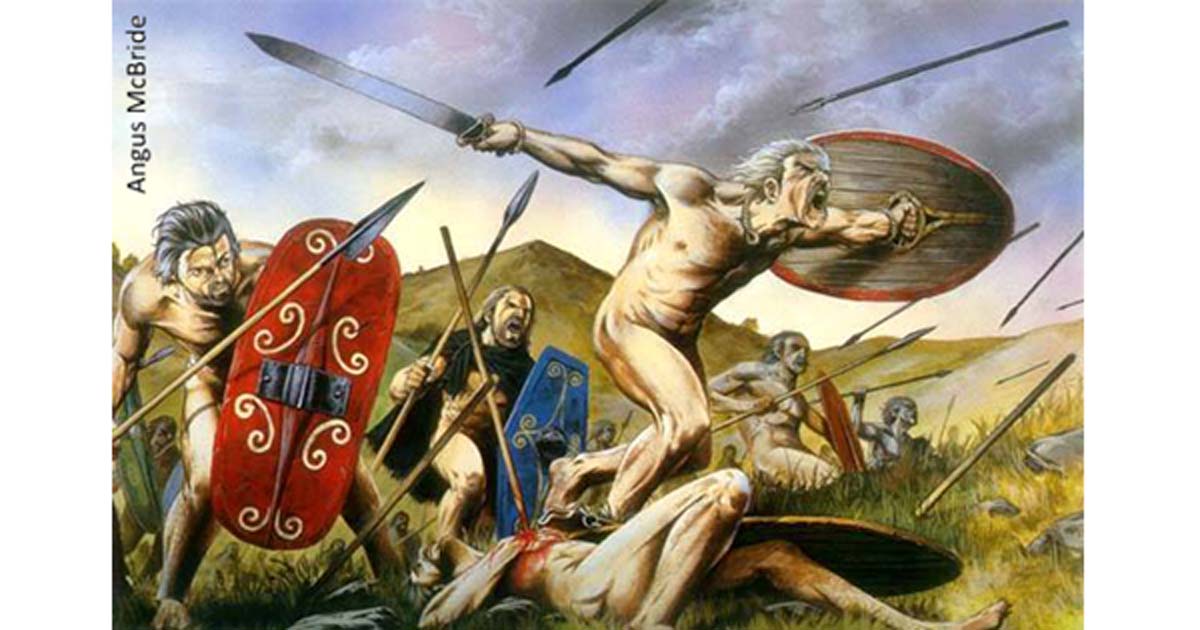Fighting in the Buff: Did Celtic Warriors Really Go to War Naked?
The Celts were known in ancient times to have been ferocious warriors. According to certain written sources, some of these Celtic warriors went a step further by going into battle carrying only their weapons and shields. Apart from texts by ancient writers, the image of such a Celtic warrior is also captured in a famous sculpture known as the ‘Dying Gaul’.

The Dying Gaul, in the Capitoline Museums, Rome. (Jean-Pol GRANDMONT/ CC BY SA 3.0)
Origins of the Celts
The Celts were a people who lived in Europe during the Iron and Medieval Ages. Whilst they are not a distinct racial or genetic group, the Celts spoke Celtic languages, and shared certain cultural similarities. There were a variety of tribes referred to as ’Celtic’ that inhabited Europe during the Iron Age. The name ‘Gaul’, for example, was given by the Romans to the Celtic tribes inhabiting the areas that are today the central, northern and eastern parts of France.
- Aquae Sulis: The Epitome of Roman Syncretization with the Celts
- Female Druids, the Forgotten Priestesses of the Celts

Ancient costumes of all nations – British, Gallic and German by Albert Kretschmer, painter and costumer to the Royal Court Theatre, 1882. (Public Domain)
A Celtic Cult of Nudity
Towards the end of the 3rd century BC, an attempt was made by a coalition of Celtic tribes from Cisalpine Gaul (the part of northern Italy inhabited by the Gauls) to attack the Roman Republic. This coalition included the Insubres, the Boii and the Taurisci. One of the decisive battles during this war was the Battle of Telamon, which was fought in 225 BC. From Polybius’ account of this battle, we hear about a ‘tribe’ of Celtic warriors known as the Gaesatae, whom the ancient author describes as having the habit of fighting naked.

Statue of a fighting Gaul dropped to one knee with left arm raised in defence. (CC AT-SA 3.0)
The Gaesatae are not exactly a tribe, as they seem to have appeared in history out of the blue, and their existence is not attested prior to the Roman-Celtic Wars. Polybius wrote that the Gaesatae were “Gauls dwelling among the Alps and near the Rhone”. The ancient historian goes on to state that the name Gaesatae actually means “serve for hire”. In other words, these Celtic warriors were mercenaries.
Enlisting the Naked Celts
In any event, messengers were sent to the Gaesatae urging them to join the Celtic coalition in their war against the Romans. “They urged and incited their kings Concolitanus and Aneroëstus to make war on Rome, offering them at present a large sum in gold, and as to the future, pointing out to them the great prosperity of the Romans, and the vast wealth that would be theirs if they were victorious.”
Additionally, the Celts “pledged themselves to be loyal allies and reminded them of the achievement of their own ancestors, who had not only overcome the Romans in combat, but, after the battle, had assaulted and taken Rome itself.”
- Monte Pindo: A Legendary Celtic Olympus from Ancient Galicia
- The Forgotten Celtic History of Ancient Poland
The Gaesatae were so eager to join this endeavour that “on no occasion has that district of Gaul sent out so large a force or one composed of men so distinguished or so warlike”. Some chapters later, Polybius writes about the clothing that the Celtic warriors wore to battle. Whilst the other Celts wore trousers and light cloaks, the Gaesatae preferred to fight naked. The fact that some Celtic warriors fought naked was also pointed out by Diodorus Siculus, though this author does not name the tribe(s) whose warriors fought in such a manner.

Celts fighting Romans. (Weapons and Warfare)
Psychological Warfare
According to Polybius, the Gaesatae fought naked for two main reasons. First of all, this was meant to display their confidence, both to their allies, and to the enemy. Secondly, it seems that it was more efficient to fight this way, “thinking that thus they would be more efficient, as some of the ground was overgrown with brambles which would catch in their clothes and impede the use of their weapons.” Thirdly, the sight of naked warriors was also intended to intimidate the enemy.
- Research Decodes Ancient Celtic Astronomy Symbols and Links them to Jungian Archetypes
- Examining the Rich Tomb of a Mysterious Celtic Princess
Unfortunately, Polybius explains the nakedness of the Gaesatae actually became a disadvantage as they faced the Roman javelin men at the Battle of Telamon:
“For the Gaulish shield does not cover the whole body; so that their nakedness was a disadvantage, and the bigger they were the better chance had the missiles of going home. At length, unable to drive off the javelineers owing to the distance and the hail of javelins, and reduced to the utmost distress and perplexity, some of them, in their impotent rage, rushed wildly on the enemy and sacrificed their lives, while others, retreating step by step on the ranks of their comrades, threw them into disorder by their display of faint-heartedness. Thus was the spirit of the Gaesatae broken down by the javelineers.”

The Dying Gaul, Ørstedsparken in Copenhagen. (CC BY-SA 3.0)
Top image: Celtic warriors in “The Battle of Telamon, 225 BC.” Credit: Angus McBride
By Wu Mingren
References
AncientMilitary.com, 2012. Celtic Warriors. [Online]
Available at: http://www.ancientmilitary.com/celtic-warriors.htm
Atlantic Religion, 2014. The Gaesatae. [Online]
Available at: https://atlanticreligion.com/2014/08/01/the-gaesatae/
Diodorus Siculus, The Library of History [Online]
[Oldfather, C. H. (trans.), 1933-1957. Diodorus Siculus’ The Library of History.]
Available at: http://penelope.uchicago.edu/Thayer/E/Roman/Texts/Diodorus_Siculus/home.html
Keating, F., 2015. The ancient Celts: Bloodthirsty naked warriors or lovers of fine arts?. [Online]
Available at: http://www.ibtimes.co.uk/ancient-celts-bloodthirsty-naked-warriors-lovers-fine-arts-1522007
Kessler Associates, 2017. Gaesatae (Gauls). [Online]
Available at: http://www.historyfiles.co.uk/KingListsEurope/BarbarianGaesatae.htm
Polybius, The Histories [Online]
[Paton, W. R. (trans.), 1922-27. Polybius’ The Histories.]
Available at: http://penelope.uchicago.edu/Thayer/E/Roman/Texts/Polybius/home.html



















